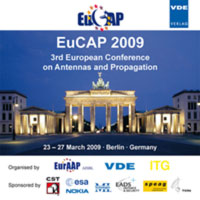Dual Polarised Multi-Layer Antenna with Complex Feeding Network
Conference: EuCAP 2009 - 3rd European Conference on Antennas and Propagation
03/23/2009 - 03/27/2009 at Berlin, Germany
Proceedings: EuCAP 2009
Pages: 4Language: englishTyp: PDF
Personal VDE Members are entitled to a 10% discount on this title
Authors:
Giacomini, A.; Foged, L. J. (SATIMO Italy, Via dei Castelli Romani 59, 00040 Pomezia, Italy)
Baracco, J. M. (MARDEL, 2423, Avenue Emile Hugues, 06140 Vence, France)
Bandinelli, M. (IDS, Via Livornese 1019, 56010 Pisa, Italy)
Sabbadini, M. (ESA/ESTEC, Keplerlaan 1, P.O. Box 299, AG Noordwijk ZH, The Netherlands)
Abstract:
Medium gain antennas, in dual polarisation, with high polarisation purity and return loss, operating over a total bandwidth of 30% or more, are needed for numerous applications in the space and ground segments. Such requirements can be satisfied with a novel antenna solutions in multi-layer composite technology as described in previous publications. The antenna consists of a suitable arrangement of layered elements acting as a 3D wave-guiding structure excited by a single or dual polarised patch element. The wave-guiding structure provides the beam focusing and the free space impedance matching of the radiated energy over a large bandwidth. The main advantage of this antenna element is the flexibility to match the overall design to a wide range of stand-alone and array configuration requirements, due to the natural separation of the antenna components responsible for the matching and gain performance. This particular characteristic enables the implementation of a very effective design procedure starting from the initial sizing and preliminary performance estimate up to the final optimization of the antenna performance. The multi-layer structure and the balanced excitation of the feeding section require an accurate numerical modelling for the initial sizing, overall optimisation and feeding network design. Modular breadboards, conducted and radiated measurements and numerical modelling refinements have been used extensively in the development of the antenna element. This paper describes the electrical and mechanical design considerations, manufacturing activity and discuss the final testing of the antenna.


